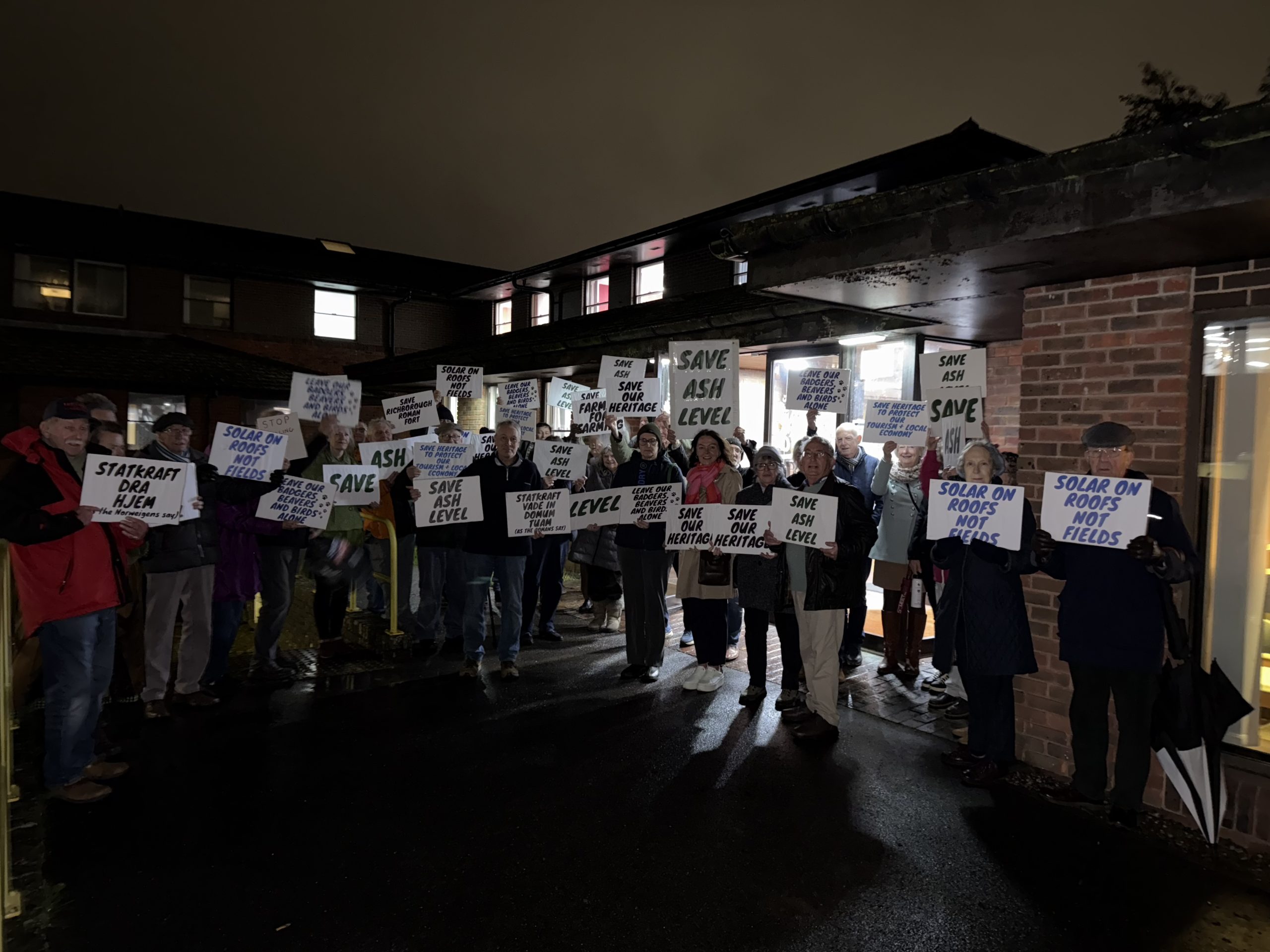

UNANIMOUSLY REFUSED!!!
November 28, 2025Councillors last night (27 November 2026) rejected plans for an industrial solar farm on 180 acres of productive farmland, located just metres from a scheduled national monument at Ash Levels near Richborough.
Dover District Council voted unanimously against the ironically named “Little South Solar Farm”, sited between historic Sandwich and Ash, with 10 in favour of the refusal, despite a previous officer recommendation.
Having appraised all the objections (over 650), the Councillors quickly asserted that the proposal would have caused ‘severe’ harm to the setting and significance of Grade 1 listed heritage assets, including the nationally and internationally significant Richborough Roman Fort – a belief already stated by scores of the country’s leading Roman and archaeology experts.
Co-Chair of Save Ash Level, Alex Ridings, said “We’re delighted by the decision to Save Ash Level and preserve the importance and setting of Richborough Roman Fort and a landscape which has been important to Britain’s history since Emperor Claudius looked out over it in AD43.”
We hope today’s decision gives hope to the multitude of similar communities fighting behemoth corporations.
It’s time the government were clearer about the guidelines to prevent schemes like this from even reaching the planning committee stage. In our case, this has been 4 years of anxiety and worry.
No doubt the applicant will look at an appeal, but the recent Planning Inspectorate decision to dismiss the appeal for a large solar farm at North Court Farm, Ashford, with significant but lesser protected landscape and heritage conditions to this scheme, gives us strong confidence we won’t see a large-scale solar farm underneath a Scheduled National Monument here.”
The committee had heard a statement from Mike Haken, the Chair of the Roman Road Association, which was endorsed by Prof. Richard Hingley – Department of Archaeology, University of Durham, Keith Parfitt – Canterbury Archaeological Trust, Prof. Jas Elsner -Department of Classics, University of Oxford, Dr John Carman – Hon. Associate Professor, School of History & Cultures, University of Birmingham, Chair, Heritage Advisory Committee of the European Association of Archaeologists and Dr. Steve Willis, University of Kent.
Mike’s statement read, “I want to express my serious concerns about this application, which I urge the committee to refuse as it is hard to imagine a more important and exceptional heritage asset than Richborough, both in terms for its surviving remains and its unique role in our nation’s story.
It is crucial for the committee to understand the heritage, landscape and archaeological context. Widely regarded as the landing place for the Roman invasion in AD43, Richborough became famed as the gateway to Britain, with one of the largest monumental arches in the Empire, 90 feet high and clad in white Carrara marble. It was designed to be seen far out to sea, proclaiming the conquest of Britain, and Richborough’s importance, to the Roman world.
There is undisputed evidence of Roman roads approaching the proposed development from both the northeast and southwest, and both Historic England and KCC Heritage Conservation agree that this suggests a route across the proposed development.
They also agree in dismissing the applicants’ claim that trial trenching proved this road does not exist. The discovery of a cremation cemetery, frequently placed along roads and routeways, supports the former presence of the Roman road.
There is a strong likelihood that organic artefacts, remains of the road’s timber substructure, and maybe even Roman vessels survive buried in the waterlogged oxygen-free deposits in the former saltmarsh – yet no analysis has been conducted on the impact of the proposed works on ground conditions and oxygen levels, or the potential harm to surviving organic artefacts and structures. Not to mention the potential mechanical damage caused by sinking piles.
Richborough, with its natural harbour, was effectively an island in the former Wantsum Channel, the remains of which is vital to the understanding and appreciation of the landscape context of the Roman site.
Paragraphs 212 & 213 of the NPPF make it very clear that the more important the heritage asset, the greater the weight that should be given to the conservation of both asset and its setting. According to the council’s archaeological advisers, harm to the site’s environmental setting would be serious and significant – I would describe it as substantial.
I firmly disagree with the Planning Officer’s inexplicable conclusion that the harm caused to one of northern Europe’s most important heritage assets is ‘less than substantial’, when almost all of the nearby part of the former channel and the natural harbour would be covered in photo-voltaics, and buried archaeology may be damaged or destroyed. The CPRE describe this as ‘fudged’ – I would state that it is in clear contravention of the NPPF.
Alongside a multitude of highly qualified eminent experts, I would urge you in the strongest terms to refuse this application.”
For further press enquiries please Contact Us
